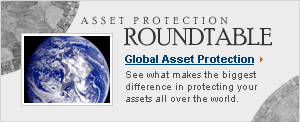Asset Protection - How does it work
We use the latest
technology to remove your assets from the reach of your creditors. We
utilize statutory law when and where it is available. The tools we may use often include asset protection trusts and/or a family
limited partnerships, llc's, insurance, annuties, and the like. ...
Regardless of the techniques utilized, all major non-statutory asset protection
techniques revolve around two common sense rules: what you do not own cannot
be taken from you, and no country in the world recognizes United States judgments.
Rule 1: What you don't own can't
be taken from you.
This simple concept is the cornerstone of solid asset
protection. If it is not yours, it is also not available to your
creditors. People with solid asset protection control everything
and own nothing. It is the same way that wealthy people and movie
stars have been doing it for years.
We use techniques that keep you in control, but at the same time separate you from technical ownership. We often use a carefully drafted asset protection trust to achieve this result. As long as the trust is developed when the financial seas are calm, and is not the result of a fraudulent conveyance, your creditors should not be able to access any assets in your trust.
Rule 2: No country in the world automatically
recognizes US judgments.
This is why we often utilize
foreign asset protection trusts. Our system forces creditors to litigate again in a foreign jurisdiction.
In most cases, a foreign country does not allow contingent
fee litigation and requires the creditor to post a bond to
pay for your legal fees if they loose. Keep in mind that even
though we utilize foreign trusts your assets will normally
remain in the USA in the repository of your choice.
In short, we use technologies that remove the economic incentive to litigate. Most contingent fee litigators are after one thing: MONEY. Once they realize that payment is at best unlikely and probably impossible because you have solid asset protection in place, these professional takers often abandon the pursuit of protected assets. They will often give up on the pursuit of your protected assets in favor of one of the many juicy unprotected targets out there.
The bottom line: We remove the economic incentive to litigate.
For a free 20 minute consultation click here.

EDUCATION SELF HELP
- Asset Protection Successfully
- Asset Protection Calm Level5
- Asset Protection Calm Testimonials
- Forms Center Home
- Trustmakers Sitemap
- Estate Questionnaire Submission
- Affiliate Login
- Contactus_sybmit
- Asset Protection Affliates Signup Old
- Application Thank You
- US Department Of Labor ERISA Prohibited Transaction
- Asset Protection Signup
- Why You Need Asset Protection
- Asset Your Estate
- Asset Protection Plans
- Asset Protection Case Studies
- Asset Protection Affliates Signup
- Contact Submission
- 20 Minute Consultation Submission
- Assess Your Situation
- Assess Situation Submission
- Asset Protection Calm Level4
- Asset Protection Affliates
- Total Asset Protection Risk Analysis
- Email Article
- Asset Protection Calm
- Asset Protection Calm Level2
- OVERVIEW
- Education Self Help
- Asset Protection With LLC
- Db
- HOW DOES ASSET PROTECTION WORK
- What Is Asset Protection
- Client Information
- Advisor Login
- Asset Protection Affiliate Terms
- Asset Protection Calm Level1
- Application Submission
- Asset Protection Consultation
- Asset Protection Calm Level3
- TrustMakers Forms Center
- TrustMakers Site Map

EDUCATION PRODUCTS

Asset Protecion Training
If you are looking for the most important concepts in Asset Protection, this is where to start! If you need to talk intelligently about protecting your net worth or you are a professional this online training program is for you!

Free Asset Protecion Course
Get our Free Online Asset Protection Video Course.
Learn how to protect yourself like the pros!


Asset Protection in a Nutshell
Clear, concise and straight forward, this e-Book will help you make sound decisions with your business and personal assets..

Protecting Assets - 70+ Video Lessons + 3 Ebooks
This e-course will give you straight forward asset protection advice you can implement now. One of the best asset protection courses available! Includes 70+ video lessons, 3 Ebooks, and 6 example legal documents!

Advanced Estate Planner
The key to a solid Asset Protection Plan is the Estate Plan. This downloadable estate organizer will help you keep track of important information about your assets and important legal documents all in one place.
















